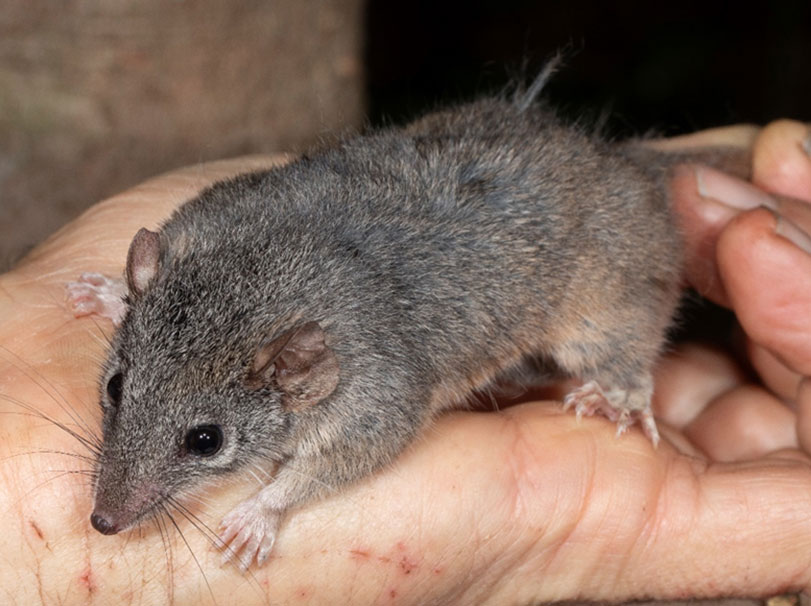Bulburin National Park—Species assessment
Species surveys were conducted to detect priority threatened species in burnt habitats. Unburnt habitats were also surveyed as a comparison, to see if they were acting as a refuge for recovery. Surveys were also used to improve the understanding of the distribution of species, population size and breeding status, where possible.
The following priority species were surveyed.
- Silver-haired antechinus Antechinus argentus
- Ringed thin-tailed gecko Phyllurus caudiannulatus
- Bulburin nut Macadamia jansenii.
Invertebrate insects and spiders restricted to Bulburin National Park were also surveyed: see the full report for details.


Silver-haired antechinus (Antechinus argentus)
The silver-headed antechinus is listed as Endangered under both the state Nature Conservation Act 1992 and the Commonwealth Environment Protection and Biodiversity Conservation Act 1999. This species is known only from three isolated, high-elevation locations in Queensland, including Bulburin National Park, which provide a cool and moist temperate climate. At Bulburin National Park, it occurs in eucalypt open forest with a dense grassy or shrubby understorey, as well as rainforest. The silver-headed antechinus is mostly nocturnal, feeding on a wide range of invertebrate prey.
A third of the modelled potential habitat for the silver-headed antechinus burnt in the 2019–2020 bushfires, which followed significant impacts from a bushfires in 2018 in other parts of its range, elevating concerns for its conservation. Two surveys were conducted a year apart, using Elliott traps, which confirmed the presence of silver-headed antechinus at both burnt and unburnt sites, and at capture rates comparable to those from surveys in May 2019, prior to the bushfires. Successful breeding was also recorded following the bushfires, and the preceding drought. Recommendations to support their ongoing conservation includes protecting rainforest habitats from fire and invasive weeds, control of feral predators, continued monitoring of populations and research to understand their habitat preferences, and broader distribution patterns.


The ringed thin-tailed gecko (Phyllurus caudiannulatus)
The ringed thin-tailed gecko is listed as Vulnerable under the Nature Conservation Act 1992. This species is a relatively small, prickly gecko with pale bands on its tail, except where it has regenerated the tail after injury or attack by a predator. This species is typically found sheltering in tree cavities, hollow logs or rock piles, within notophyll vine forest.
An estimated 28% of the modelled potential habitat of the ringed thin-tailed gecko in Bulburin National Park was burnt during the bushfires of 2019–2020. Nocturnal spotlighting surveys were conducted across burnt and unburnt sites in suitable rainforest habitat. Across 32 survey sites, a total of 25 ringed thin-tailed geckos were detected in unburnt and burnt habitat, although the average number per site seen on the burnt sites was 43% lower than that for unburnt sites. In areas impacted by the bushfires, the ringed thin-tailed gecko was only found on habitat structures that escaped the flames. The loss of these critical habitat features, such as large logs and fig trees, during the 2019–2020 fires is of significant concern, given the very slow rate of their regeneration.
Recommendations to support the recovery of the ringed thin-tailed gecko includes excluding fire from optimal habitat, preventing incursion of weeds such as cat’s claw creeper, and controlling feral cats, foxes, deer and pigs. Public access will continue to be restricted to protect gecko populations from illegal collection and the potential ris of introducing disease.


The Bulburin nut (Macadamia jansenii)
The Bulburin nut is one of four threatened macadamia species endemic to Australia and is listed as Endangered under the Commonwealth Environment Protection and Biodiversity Conservation Act 1999. A long-lived rainforest tree, the Bulburin nut is only known from small populations within Bulburin National Park and produces few seeds in the wild, increasing the challenges to protecting the species. The Bulburin nut has been reintroduced to new locations in Bulburin National Park and adjacent lands to reduce the risk of extinction.
The 2019–2020 bushfires burnt an estimated 15% of the modelled potential habitat of the Bulburin nut. Fire impacted populations were surveyed for post-fire survival and regeneration. Overall, 83% of the surveyed population survived the 2019–2020 bushfires, with Bulburin nuts often found to be reshooting from the base. A total of 35 plants were killed by the bushfires, which were mostly seedlings. The patchiness of the fires resulted in unburnt or mildly burnt areas within the fire extent, and Bulburin nuts escaping direct fire impacts. Post-fire seed germination was recorded, and their future growth and survival will be tracked as part of an ongoing monitoring program. Protecting the rainforest habitats from future fire and invasive plants is now a priority, as well as research to better understand the genetic diversity of wild Bulburin nut populations.


